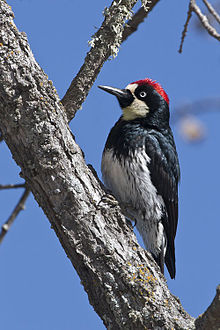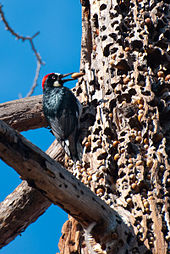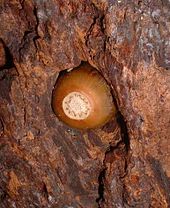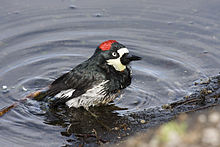- Acorn Woodpecker
-
Acorn Woodpecker 
Male in California, USA 
Female in Arizona, USA Conservation status Scientific classification Kingdom: Animalia Phylum: Chordata Class: Aves Order: Piciformes Family: Picidae Genus: Melanerpes Species: M. formicivorus Binomial name Melanerpes formicivorus
(Swainson, 1827)The Acorn woodpecker (Melanerpes formicivorus) is a medium-sized woodpecker, 21 cm long with an average weight of 85 g.
Contents
Description
The adult Acorn Woodpecker has a brownish-black head, back, wings and tail, white forehead, throat, belly and rump. The eyes are white.There is a small part on the small of their backs were there are some green feathers. The adult male has a red cap starting at the forehead, whereas females have a black area between the forehead and the cap. The white neck, throat and forehead patches are distinctive identifiers.When flying,they take a few flaps of their wings and drop a foot or so.You can see white circles on the wings while flying. Acorn woodpeckers have a call that is almost like they are laughing.
Breeding communities
The breeding habitat is forested areas with oaks in the hills of coastal areas and foothills of California and the southwestern United States south to Colombia. This species may occur at low elevations in the north of its range, but rarely below 1000m in Central America, and it breeds up to the timberline. The breeding pair excavate a nest in a large cavity in a dead tree or a dead part of a tree. A group of adults may participate in nesting activities: Field studies have shown that breeding groups range from monogamous pairs to breeding collectives of seven males and three females, plus up to 10 nonbreeding helpers. Young have been found with multiple paternity.[1]
they are green and have a pink toungh.
Food and homes
Acorn woodpeckers, as their name implies, depend heavily on acorns for food. In some parts of their range (e.g., California), the woodpeckers create granaries or "acorn trees" by drilling holes in dead trees, dead branches, telephone poles and wooden buildings. The woodpeckers then collect acorns and find a hole that is just the right size for the acorn. As acorns dry out, they are moved to smaller holes and granary maintenance requires a significant amount of the bird's time. They also feed on insects, sap, and fruit.
Defense and storing
The acorns are visible, and the group defends the tree against potential cache robbers like Steller's Jays and Western Scrub Jays. Acorns are such an important resource to the California populations that Acorn Woodpeckers may nest in the fall to take advantage of the fall acorn crop, a rare behavior in birds.[2] Acorn Woodpeckers can also be seen sallying from tree limbs to catch insects, eating fruit and seeds, and drilling holes to drink sap. The Acorn Woodpecker will use any human-made structures to store acorns, drilling holes into fence posts, utility poles, buildings, and even automobile radiators. Occasionally the woodpecker will put acorns into places where it cannot get them out. Woodpeckers put 220 kg (485 lb) of acorns into a wooden water tank in Arizona. In parts of its range the Acorn Woodpecker does not construct a granary tree, but instead stores acorns in natural holes and cracks in bark. If the stores are eaten, the woodpecker will move to another area, even going from Arizona to Mexico to spend the winter.
Breeding behavior
In California, Acorn Woodpeckers breed from May – July. An Acorn Woodpecker group may consist of 1-7 male breeders that compete to mate with 1-3 females. The nest is excavated in a large tree, which may also be a granary tree. Tree cavities are created in both dead and living trees and snags and nest holes are reused for many years. Females typically lay 5 eggs that are incubated for 11–14 days. Male and females incubate and tend to their young. Non-breeding helpers (young from previous years) often help with incubation and other parental duties. The young leave the nest and take their first flight at approximately 30–32 days after hatching and return to the nest to be fed for several weeks.
Breeding female
In groups with more than one breeding female, the females put their eggs into a single nest cavity. A female usually destroys any eggs in the nest before she starts to lay, and more than one third of all eggs laid in joint nests are destroyed. Once all the females start to lay, they stop removing eggs.
This bird is a permanent resident throughout its range. They may relocate to another area if acorns are not readily available. It is sedentary and very sociable.
Threats and degradation
Acorn Woodpeckers like many other species are threatened by habitat loss and degradation. Competition for nest cavities by non-native species is an ongoing threat in urbanized areas. Conservation of this species is dependent on the maintenance of functional ecosystems that provide the full range of resources upon which the species depends. These include mature forests with oaks capable of producing large mast crops and places for the woodpeckers to nest, roost, and store mast. Residents are encouraged to preserve mature oak and pine-oak stands of trees and to provide dead limbs and snags for nesting, roosting and granary sites to help preserve the Acorn Woodpeckers population.
Popular culture
Walter Lantz is believed to have patterned the call of his cartoon character Woody Woodpecker on that of the acorn woodpecker, while patterning his appearance on that of the Pileated Woodpecker which has a prominent crest.[3]
Notes
- ^ Joste, N., Ligon, D., and Stacey, P. (1985) Behavioral Ecology and Sociobiology; Behavioral Ecology and Sociobiology 17(1):39-41
- ^ Koenig, W.D., and Stahl, J.T. (2007) Condor; 109(2):334-350
- ^ "Woody The Acorn (Not Pileated) Woodpecker". NPR. http://www.npr.org/templates/story/story.php?storyId=101665227. Retrieved 2011-09-14.
References
- BirdLife International (2004). Melanerpes formicivorus. 2006. IUCN Red List of Threatened Species. IUCN 2006. www.iucnredlist.org. Retrieved on 10 May 2006.
- Haydock J., Koenig W. D., & Stanback, M. T. (2001). Shared parentage and incest avoidance in the cooperatively breeding acorn woodpecker. Molecular Ecology, 10, 1515-1525.
- Stiles, F Gary; Skutch, Alexander Frank (1989), A guide to the birds of Costa Rica, Ithaca, New York: Comstock, ISBN 0-8014-2287-6
External links
- Cornell Lab of Ornithology species account
- Acorn Woodpecker (Archived 2009-10-24), a bibliographic resource
- USGS
- Acorn Woodpecker videos, photos & sounds on the Internet Bird Collection
- Stamps (for El Salvador, Mexico) with RangeMap
- Acorn Woodpecker photo gallery VIREO-(distinctive white face-throat patches)
- Photo-High Res FWS-Fish & Wildlife Service: Digital Repository
Categories:- IUCN Red List least concern species
- Woodpeckers
- Melanerpes
- Birds of the United States
- Native birds of the Southwestern United States
- Native birds of the Pacific region U.S.
- Birds of Mexico
- Birds of Cordillera Neovolcanica Mexico
- Birds of Central America
- Birds of El Salvador
- Birds of Colombia
- Fauna of the California chaparral and woodlands
Wikimedia Foundation. 2010.




